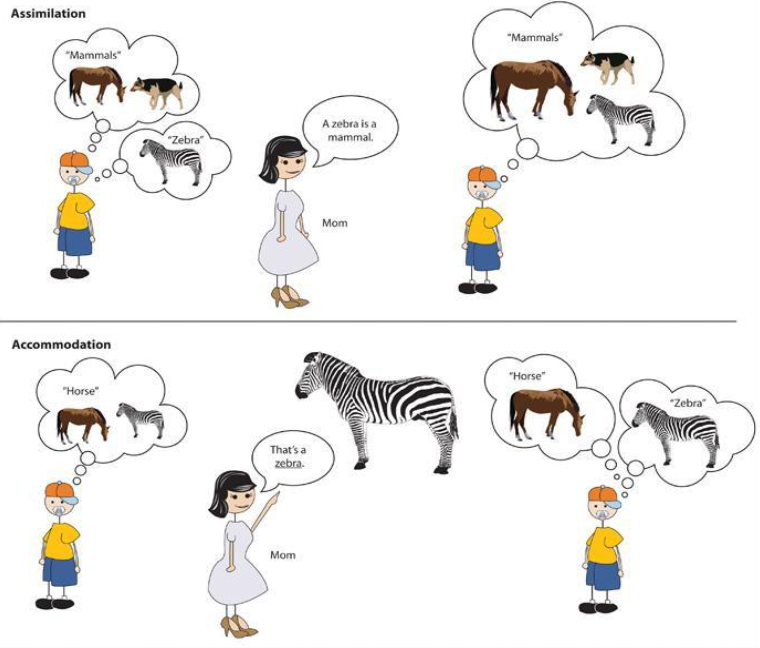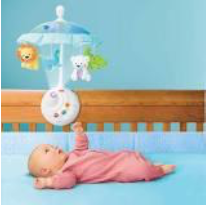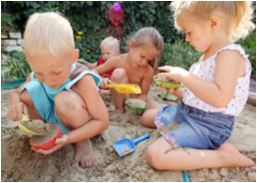Coordination Of Secondary Circular Reactions
iii.half dozen: Piaget and the Sensorimotor Stage
- Page ID
- 10192
Learning Objectives: Cognitive Development in Infancy and Toddlerhood
- Compare the Piagetian concepts of schema, assimilation, and accommodation
- List and describe the half-dozen substages of sensorimotor intelligence
- Describe the characteristics of babe memory
- Draw components and developmental progression of language
- Identify and compare the theories of language
Schema, Absorption and Accommodation
Piaget believed that we are continuously trying to maintain cognitive equilibrium, or a residual, in what we meet and what we know (Piaget, 1954). Children have much more of a challenge in maintaining this residue because they are constantly beingness confronted with new situations, new words, new objects, etc. All this new data needs to be organized, and a framework for organizing information is referred to as a Schema. Children develop schemata through the processes of absorption and accommodation.
When faced with something new, a child may demonstrate Assimilation , which is fitting the new information into an existing schema, such as calling all animals with four legs "doggies" because he or she knows the word doggie. Instead of assimilating the data, the child may demonstrate Accommodation, which is expanding the framework of knowledge to adapt the new state of affairs and thus learning a new word to more accurately proper noun the brute. For example, recognizing that a horse is different than a zebra ways the child has accommodated, and now the child has both a zebra schema and a horse schema. Even equally adults we continue to try and "make sense" of new situations by determining whether they fit into our old way of thinking (assimilation) or whether we need to modify our thoughts (accommodation).

Co-ordinate to the Piagetian perspective, infants larn about the world primarily through their senses and motor abilities (Harris, 2005). These bones motor and sensory abilities provide the foundation for the cognitive skills that will emerge during the subsequent stages of cognitive development. The beginning stage of cognitive development is referred to every bit the Sensorimotor Period and information technology occurs through half dozen substages. Table three.2 identifies the ages typically associated with each substage.
| Substage 1 | Reflexes (0-1 calendar month) |
|---|---|
| Substage 2 | Primary Circular Reactions (one-4 months) |
| Substage 3 | Secondary Round Reactions (4-viii months) |
| Substage 4 | Coordination of Secondary Round Reactions (viii-12 months) |
| Substage five | Tertiary Round Reactions (12-18 months) |
| Substage vi | Beginning of Representational Idea (18-24 months) |
Substage 1: Reflexes. Newborns acquire about their globe through the employ of their reflexes, such as when sucking, reaching, and grasping. Eventually the use of these reflexes becomes more than deliberate and purposeful.
Substage 2: Master Circular Reactions. During these next three months, the infant begins to actively involve his or her own trunk in some form of repeated activity. An infant may accidentally engage in a behavior and find it interesting such every bit making a vox. This interest motivates trying to do information technology once more and helps the infant acquire a new behavior that originally occurred by chance. The behavior is identified equally circular and primary because it centers on the baby's own body.
Substage 3: Secondary Circular Reactions. The infant begins to interact with objects in the surroundings. At first the baby interacts with objects (e.yard., a crib mobile) accidentally, just then these contacts with the objects are deliberate and become a repeated activeness. The infant becomes more and more actively engaged in the outside world and takes please in being able to make things happen. Repeated motion brings particular interest as, for instance, the baby is able to blindside ii lids together from the cupboard when seated on the kitchen floor.

Substage 4: Coordination of Secondary Circular Reactions. The babe combines these basic reflexes and uses planning and coordination to achieve a specific goal. At present the infant tin engage in behaviors that others perform and anticipate upcoming events. Perhaps because of continued maturation of the prefrontal cortex, the infant get capable of having a thought and carrying out a planned, goal-directed action. For instance, an infant sees a toy auto under the kitchen tabular array and and so crawls, reaches, and grabs the toy. The infant is coordinating both internal and external activities to achieve a planned goal.
Substage 5: Tertiary Circular Reactions. The toddler is considered a "petty scientist" and begins exploring the earth in a trial-and-error mode, using both motor skills and planning abilities. For case, the child might throw her ball down the stairs to see what happens. The toddler'due south active engagement in experimentation helps them acquire near their world.
Substage vi: Commencement of Representational Idea. The sensorimotor menses ends with the appearance of symbolic or representational thought. The toddler now has a basic agreement that objects can be used as symbols. Additionally, the child is able to solve problems using mental strategies, to remember something heard days before and repeat information technology, and to engage in pretend play. This initial motility from a "hands-on" approach to knowing nigh the world to the more than mental world of substage 6 marks the transition to preoperational thought.

Development of Object Permanence
A critical milestone during the sensorimotor menses is the evolution of object permanence. Object permanence is the understanding that even if something is out of sight, information technology even so exists (Bogartz, Shinskey, & Schilling, 2000). According to Piaget, young infants do non remember an object later on it has been removed from sight. Piaget studied infants' reactions when a toy was get-go shown to an infant and so hidden under a coating. Infants who had already developed object permanence would achieve for the subconscious toy, indicating that they knew it notwithstanding existed, whereas infants who had not developed object permanence would appear confused. Piaget emphasizes this construct because it was an objective way for children to demonstrate that they tin can mentally represent their earth. Children take typically caused this milestone by eight months. In one case toddlers have mastered object permanence, they enjoy games similar hide and seek, and they realize that when someone leaves the room they will come dorsum. Toddlers also point to pictures in books and look in advisable places when you ask them to discover objects.
In Piaget'due south view, around the same time children develop object permanence, they also brainstorm to exhibit Stranger Anxiety, which is a fear of unfamiliar people (Crain, 2005). Babies may demonstrate this by crying and turning abroad from a stranger, by clinging to a caregiver, or by attempting to reach their artillery toward familiar faces such as parents. Stranger feet results when a child is unable to assimilate the stranger into an existing schema; therefore, she can't predict what her feel with that stranger will be like, which results in a fear response.
Critique of Piaget: Piaget thought that children's ability to understand objects, such every bit learning that a rattle makes a dissonance when shaken, was a cognitive skill that develops slowly as a child matures and interacts with the environment. Today, developmental psychologists think Piaget was incorrect. Researchers have establish that even very immature children empathise objects and how they work long earlier they have feel with those objects (Baillargeon, 1987; Baillargeon, Li, Gertner, & Wu, 2011). For instance, Piaget believed that infants did not fully primary object permanence until substage v of the sensorimotor period (Thomas, 1979). However, infants seem to be able to recognize that objects have permanence at much younger ages. Diamond (1985) institute that infants show earlier knowledge if the waiting catamenia is shorter. At historic period half-dozen months, they retrieved the hidden object if their expect for retrieving the object is no longer than ii seconds, and at 7 months if the wait is no longer than four seconds.
Even before, children as immature as 3 months onetime demonstrated knowledge of the properties of objects that they had merely viewed and did not have prior experience with them. In one study, 3-month-old infants were shown a truck rolling down a runway and behind a screen. The box, which appeared solid just was actually hollow, was placed side by side to the track. The truck rolled past the box as would be expected. And then the box was placed on the runway to block the path of the truck. When the truck was rolled downwardly the runway this time, it continued unimpeded. The infants spent significantly more time looking at this impossible event (Figure 3.16). Baillargeon (1987) concluded that they knew solid objects cannot laissez passer through each other. Baillargeon's findings suggest that very young children have an understanding of objects and how they work, which Piaget (1954) would accept said is beyond their cognitive abilities due to their limited experiences in the world.

Coordination Of Secondary Circular Reactions,
Source: https://socialsci.libretexts.org/Bookshelves/Human_Development/Book%3A_Lifespan_Development_-_A_Psychological_Perspective_(Lally_and_Valentine-French)/03%3A_Infancy_and_Toddlerhood/3.06%3A_Piaget_and_the_Sensorimotor_Stage
Posted by: daviswillith1981.blogspot.com


0 Response to "Coordination Of Secondary Circular Reactions"
Post a Comment